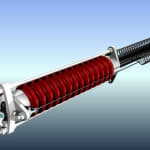 DuPont Performance Polymers and Ireland-based Technology from Ideas (TFI) collaborated to develop a novel way to allow moored devices to move with the sea, which dramatically reduces peak loads up to 70% and improves durability of mooring lines that tether and protect high-value marine devices, such as wave energy devices and fish farms.
DuPont Performance Polymers and Ireland-based Technology from Ideas (TFI) collaborated to develop a novel way to allow moored devices to move with the sea, which dramatically reduces peak loads up to 70% and improves durability of mooring lines that tether and protect high-value marine devices, such as wave energy devices and fish farms.The new Dynamic Tethers wave protection system replaces chain and rope mooring, which pulls taut, rattles and wears quickly as it moves against the sea. It incorporates an energy-damping bellow that acts similar to a "shock absorber", which delivers high load and fatigue resistance to protect devices from harsh sea wave conditions, designed to stay slightly taut and respond smoothly when stretched to its limit, while dramatically reducing wear and tear, improving stability, reliability and positioning and lowering cost.
The energy-damping bellow is extruded by Radius Systems Ltd. In Banbridge, Ireland using DuPont Hytrel TPC-ET polyester thermoplastic elastomer and a tensile elastomer element made of a soft material with low stiffness which deliver the low force response of the system with elongations of up to 250% of the original length, while withstanding repeated low-force events (>3.5 million cycles per year). The energy-dampening bellow is 1.2 meters (nearly 4 ft) long, 250 mm (nearly 10 inches) in diameter and weighs 20 kg (44 lb) and is engaged as the tether reaches its maximum extension and is designed to deliver a specific targeted smooth response as it compresses.

The new tethers are being monitored at a number of installations in Europe and are expected to be commercially available in early 2015. "The design takes advantage of the elasticity and flex fatigue of Hytrel," said Mark Hazel, technical specialist for DuPont Performance Polymers. "We adapted our technology for constant velocity joint (CVJ) boots, which are a mainstay in the automotive industry, and developed a highly functional bellow to handle the extreme load conditions and meet the demanding overall performance requirements of the marine industry."
"The key to develop such wave protection system is to ensure excellent fatigue resistance coupled with high performance over time in sea water. Hytrel thermoplastic elastomer was selected over competitive materials due to its excellent load recovery performance," added Noel Halloran, TFI's CEO.
In the development process, TFI provided the load deflection curve for a quarter-scale model and DuPont's computer-aided engineering (CAE) experts used their design knowledge from automotive shock-absorbing bellows to create a Hytrel bellow with corrugations of different pitch that compress at different rates to give increasing stiffness as the compression progresses. Advanced finite-element analysis (FEA) techniques were used to ensure the design met the performance specification.


